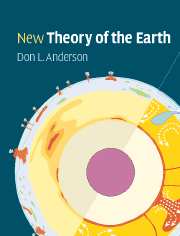Book contents
- Frontmatter
- Contents
- Preface and Philosophy
- Abbreviations and acronyms
- Part I Planetary perspective
- Part II Earth: the dynamic planet
- Part III Radial and lateral structure
- Part IV Sampling the Earth
- Part V Mineral physics
- Part VI Origin and evolution of the layers and blobs
- Chapter 23 The upper mantle
- Chapter 24 The nature and cause of mantle heterogeneity
- Chapter 25 Crystallization of the mantle
- Part VII Energetics
- References and notes
- Appendix
- Index
Chapter 25 - Crystallization of the mantle
Published online by Cambridge University Press: 05 June 2012
- Frontmatter
- Contents
- Preface and Philosophy
- Abbreviations and acronyms
- Part I Planetary perspective
- Part II Earth: the dynamic planet
- Part III Radial and lateral structure
- Part IV Sampling the Earth
- Part V Mineral physics
- Part VI Origin and evolution of the layers and blobs
- Chapter 23 The upper mantle
- Chapter 24 The nature and cause of mantle heterogeneity
- Chapter 25 Crystallization of the mantle
- Part VII Energetics
- References and notes
- Appendix
- Index
Summary
Rocks, like everything else, are subject to change and so also are our views on them.
Franz Y. Loewinson-LessingThe Earth is cooling and crystallizing. The mantle has evolved considerably from the magma ocean era to the plate tectonic era. Part of the evolution is due to igneous processes, and part is due to plate tectonic processes. The visible rocks are the end, or present, product of mantle evolution. If these were our only source of information, we could come up with a fairly simple scheme of magma genesis, perhaps involving single-stage melting of a homogenous, even primitive, mantle. We could design simple one- and two-layer mantle models, such as were popular in the last century. It now seems unlikely that we will find the ‘Rosetta Stone,’ a rock or a meteorite fragment that represents ‘original Earth’ or even the parent or grandparent of other rocks. Rocks and magmas represent products of complex multistage processes, and they are mixtures of components with various melting histories. As we delve deeper into the Earth and further back in time, we depend more and more on isotopes and on modeling of planetary accretion and mantle processes. Melts and rocks are averages of various components and processes. Sampling theory and the manipulation of averages are involved in this modeling. In addition to recycling, and an intrinsically heterogenous mantle, there are igneous processes that cause chemical heterogeneity interior to the mantle. Melt trapping and melt transport can create distinctive chemical and isotopic components.
- Type
- Chapter
- Information
- New Theory of the Earth , pp. 318 - 330Publisher: Cambridge University PressPrint publication year: 2007



